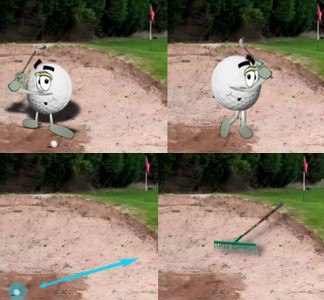 There are two things a golfer must do when his ball goes into a bunker (aka sand trap). First, you’ve got to get the ball out. Next, you’ve got to rake the sand to cover your footprints and divot.
There are two things a golfer must do when his ball goes into a bunker (aka sand trap). First, you’ve got to get the ball out. Next, you’ve got to rake the sand to cover your footprints and divot.
You may be wondering if it’s really necessary to rake the bunker. What difference does it make if the sand isn’t perfect, right? Actually, it makes a huge difference. Try hitting a ball out of a footprint or a deep gouge and you’ll understand. Few things make a golfer angrier than discovering the ball in a terrible lie because someone carelessly ignored this basic obligation.
To be fair, many golfers who neglect to rake – especially beginners — do so because they’re in a rush to move on and let the next group hit. True, raking does take a little time. But as long as you do it briskly, no one will hold it against you.
Here’s how:
- First, locate the shortest and easiest route from the edge of the bunker to your ball. Some bunkers have steep lips that are difficult to scramble up and down, so you’re better off entering at a lower point even if the walk is longer.
- This part is key: Take a rake with you into the sand. Place it near your ball, but out of the way of your swing.
- Try not to wander around in the bunker and create extra tracks. Go directly to your ball and make a couple of practice swings from beside or behind it. This will limit the amount of sand you must rake.
- Once you’ve escaped, grab the rake and find your original footprint trail. Re-trace it while walking backward and raking as you go, smoothing over all footprints until you reach the end.
- When raking, stroke the sand just hard enough to eliminate any ridges or rough spots without digging trenches with the tines. You can always look around at other raked spots for examples.
Raking bunkers is one of those tedious acts required in golf. But you should never, ever ignore this important task. Your fellow golfers would prefer to wait for you to rake, rather than get stuck in a footprint.





